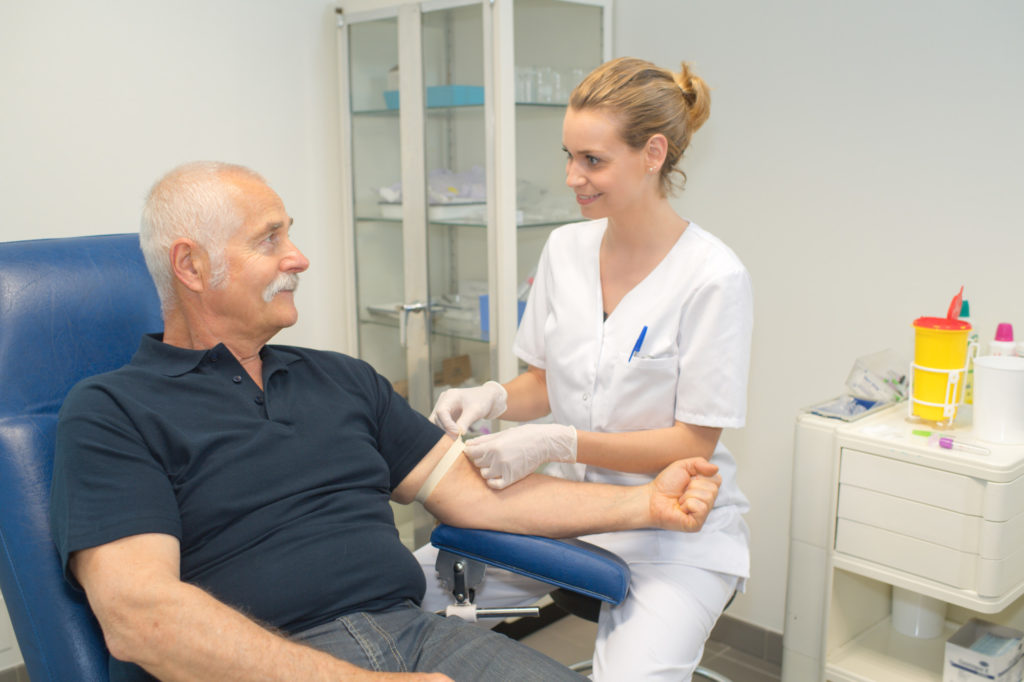What Is a Phlebotomist?

Every year over 6.8 million people donate blood in the U.S. This equates to more than 13.6 million units of whole blood. But who checks the quality of this blood?
If you haven’t donated or had your blood tested, you probably haven’t dealt with a phlebotomist before. So it’s no surprise that you may be asking yourself “what is a phlebotomist?”
A phlebotomist is a medical technician trained in drawing blood samples from patients. They work in hospitals, clinics, and other healthcare facilities to collect blood samples.
You might still be interested in the role of a phlebotomy technician. In this article, we give you the answers so know exactly what a phlebotomist does, what they do after you’ve had blood taken, and how to get into this rewarding career. Read on to find out more.
What Is A Phlebotomist?
A phlebotomist is a medical professional who has been trained to collect and prepare blood samples for testing and analysis in a medical laboratory. They are also qualified to perform blood transfusions as well as collect donations of blood.
In the medical field, the process of collecting blood samples is known as venipuncture, which involves a needle being inserted into the vein. Phlebotomists are also trained in performing finger pricks and heel pricks on infants to collect blood samples.
The purpose of collecting these blood samples is to be tested for various health conditions, allowing medical professionals to screen, diagnose and monitor illnesses. Although nurses are also trained to draw blood samples, this is the primary focus of a phlebotomist’s job.
Where Does The Word Phlebotomy Come From?
The word “phlebotomy” comes from Greek words meaning “vein” and “cutting”. Therefore, phlebotomy refers to the process of cutting or puncturing veins in order to obtain blood samples.
What Does A Phlebotomist Do?
A phlebotomist is responsible for collecting blood samples. This includes drawing blood from patients, they may also collect other bodily fluids and prepare them for laboratory testing. Here’s a list of different tasks a phlebotomist may also do.
- Helping to prepare individuals for blood draws, which can include calming someone who may be nervous or afraid of needles
- Confirming the identity of the person before the blood draw and ensuring that all collection vials are properly labeled
- Ensuring that all equipment is clean and sterile prior to collecting blood
- Administering blood draws and transfusions for patients
- Assisting with any adverse reactions following a blood draw or transfusion
- Organizing and keeping track of the collected blood samples to deliver them to testing laboratories or a blood bank
- Working alongside physicians and other healthcare professionals
- Managing the supplies needed for performing blood draws
Where Do Phlebotomists Work?
Phlebotomists are health professionals who work in a wide range of locations. This includes clinical laboratories, hospitals, community health centers, assisted living facilities and nursing homes, and doctor’s offices.
They can also work at blood donation centers and drives. In most cases, they are managed or overseen by clinical laboratory technologists or other medical personnel.
How Do You Become A Phlebotomist?
The primary need to become a phlebotomist is a high school diploma or equivalent. You’ll also need successful completion of a phlebotomy technician training program. This typically lasts from several months to one year.
Certification is also essential for this role. The National Healthcareer Association, American Medical Technologists, and the American Society of Clinical Pathologists are all organizations that offer certification options.
Depending on where you’re based, four states additionally require special state certifications. These include California, Washington, Nevada, and Louisiana. On top of this, most employers require ongoing training for phlebotomists. This is to maintain their certification; this could involve extra training hours periodically.
Skills Needed To Become A Phlebotomist
A phlebotomist needs more than just the educational requirements to succeed in the role. Excellent interpersonal and communication skills are also essential for managing anxious patients. Plus providing information about procedures and building rapport with them.
Additionally, having a calm demeanor can go a long way toward helping put the patient at ease before any blood draws take place. Here are other key skills you should have:
- Excellent attention to detail
- Thorough understanding and adherence to safety regulations
- Can be a team player
- Possesses exceptional communication skills
- Can show compassion and empathy and has the patience to work with a range of patients
- Are adaptable and dependable
How Long Does It Take To Become A Phlebotomist?
After completing the program, you will need to pass a certification exam. This is usually followed by an internship or externship experience that lasts for about 6 weeks. After becoming certified and having some hands-on experience, you’ll be ready to start your career as a phlebotomist!
Phlebotomy offers quite a few advantages to its practitioners. For one, it is a relatively low-cost career to get into and the salary ranges can be very appealing. All in all, to become an accredited phlebotomist, most programs usually take a year or less to complete.
What’s The Average Salary Of A Phlebotomist?
The U.S. Bureau of Labor Statistics reports that the average annual salary of a phlebotomist in 2021 was $37,380. But, this may vary based on geographic location and hours worked per week.
Interested In Becoming A Mobile Phlebotomist?
So we’ve answered the question about “What Is A Phlebotomist”, do you think you have what it takes to become one? Phlebotomists play a vital role in helping to ensure the accuracy of collected blood samples. They also assist with transfusions for medical professionals.
Do you have an interest in healthcare and are looking for a job with travel and flexible hours? Then becoming a mobile phlebotomist could be an ideal career choice. If you’re interested in joining our team, then email your resume to us today.
